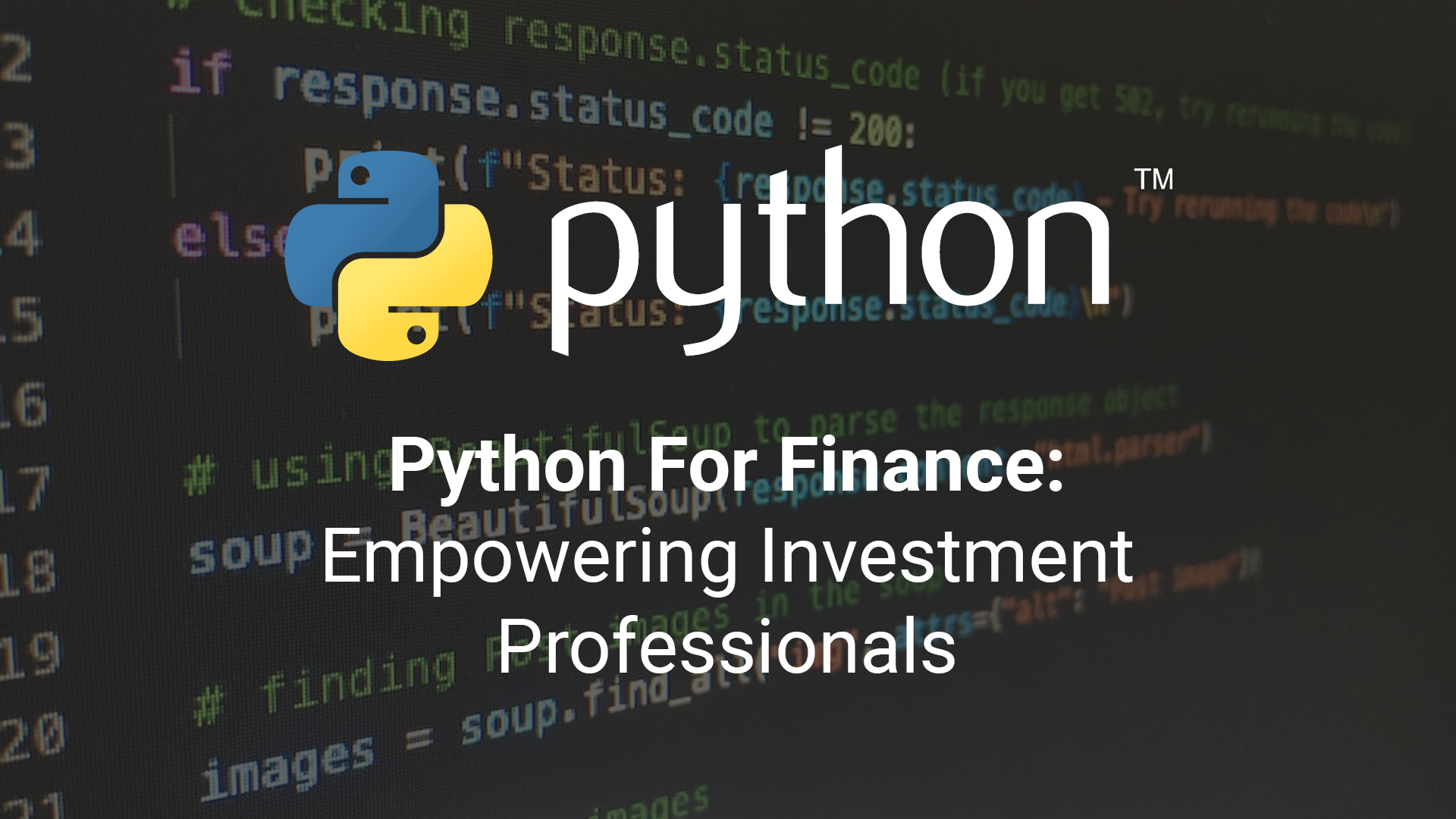Python is a powerful programming language that is increasingly being used in the finance industry. It is known for its simplicity, flexibility, and ability to handle large data sets.
In this blog post, we will discuss the following topics:
What is Python?
Python is an interpreted, object-oriented programming language. Furthermore, it’s one of the most popular programming languages in the world, and it is used in a wide variety of industries, including finance.
Python is known for its simplicity and readability. Especially its syntax is very similar to English, which makes it easy to learn and use. Python is also very versatile, and it can be used for a variety of tasks, including data analysis, machine learning, and web development.
In brief, this blog will focus on how Python plays a crucial role in financial analysis and decision-making.
How is Python used in Finance?
Python has emerged as the top choice for data science in the finance sector. Its intuitive code, efficient operations, and ability to handle massive datasets have propelled it ahead of alternatives like R. Moreover, Python’s extensive package ecosystem equips finance professionals with tools to perform complex analyses and automate daily tasks.
Python’s application in finance spans various areas:
- Data Gathering: Importing data from Excel, CSV files, web scraping, PDFs, SQL databases, and more
- Data Visualization: Creating insightful graphs, charts, and interactive dashboards
- Data Analysis: Summarizing data, adding custom formulas, sorting, filtering, and pivot tables
- Data Aggregation & Cleaning: Merging datasets, handling missing or incorrect data, and more
Popular Packages – The “Scientific” Stack – The Essentials
Python’s power is amplified through packages that extend its core functionality. These packages provide ready-to-use functions, automating routine tasks. For example, the pandas package simplifies data manipulation by offering easy-to-use commands for data import and manipulation. This convenience can significantly enhance productivity and streamline financial workflows.
Key Python packages for finance include:
- NumPy
- Provides a powerful set of mathematical and statistical functions
- Very similar to MATLAB
- Primary uses: random numbers, statistical and matrix operations
- Matplotlib
- 2D and 3D visualization package
- Makes graphs similar to those in MATLAB
- Useful for time series and cross-sectional data
- Pandas
- One of the most popular packages in Python
- “Stands” for Python Data Analysis Library
- Allows Python to handle cross sectional or time series data easier
- Stores data in “DataFrames” (think Excel tables)
- Allows for labelling of variables
- Provides built in functionality to handle typical missing data, reshaping, merging, sub-setting and other operations
- SciPy
- Includes many common numerical functions, including Integration, Optimization, Interpolation, and many others
- Optimization is a common problem in finance, especially in portfolio selection
- The minimization function is used to find the weights of the optimal portfolio
- scikit-learn
- Popular machine learning (ML) package that provides popular ML algorithms such as classification, regression, cluster detection, dimensionality reduction, data preprocessing and model selection
- Popular use in finance is for Principal Component Analysis to perform factor analysis on financial data
Other Programs vs Python
Python’s popularity is surging in finance, as it outshines other programs like VBA, R, and even Excel. In addition, Python’s versatility as a full-fledged programming language, combined with its ease of learning and extensive package support, has made it the preferred choice for modern financial analysis.
Python vs Excel
- Python is a lot more efficient in manipulating larger data sets
- Unlike Python, Excel has a limit of 1,048,576 rows
- Even at ~50,000 rows of data, Excel starts to slow down when you have multiple lookup functions, SUMIFS, pivot tables, etc.
- Python allows for automation (repeating the same analysis every week, month, quarter, etc.)
Visual Basic for Applications (VBA) vs Python
- VBA is still considered the pinnacle programming language for financial professionals due to its integration with Microsoft Office applications
- VBA is great when specific objects or things are manipulated inside Excel (such as inserting or deleting sheets, cells, formatting tables, charts, etc.)
- However, when it comes to data manipulation, aggregation, or more complex analysis, Python is easier to use
- Not only is Python easier to write (it looks more like “plain English” than VBA does) but some programs could take hundreds of lines of code in VBA while only a dozen in Python
- VBA also runs into the same issues as Excel when working with larger data sets, because at the end of the day it is still manipulating the data inside Excel
Python for Finance Use Cases
Python’s application in finance is diverse and impactful:
-
Due diligence Activities:
- You can use Python to automate tasks such as web scraping, data aggregation, and analysis. This can save time and money during the due diligence M&A process.
- Example: Retailer M&A analysis
- Python Application: Extract all Target retail locations and analyze proximity to Acquirer locations. Use this data to calculate synergy benefits of closing stores within a predetermined radius.
- Example: Consumer Product M&A analysis
- Python Application: Extract and analyze all competitor product information on retailing websites. Ability to track volumes and pricing over time and compare Target and Acquirer product strategies.
-
Risk management:
- Python can be used to model and analyze risk. You can use this to identify and mitigate risks before they occur.
-
Sell-Side M&A Process:
- Building outreach lists, managing document collections.
- Example: Identify cold-call reach out list for teaser
- Python Application: Scrape names and job title from corporate or industry websites to create a contact list for a CIM.
- Example: PIB construction and document collection
- Python Application: Access, download and organize all the files on a company’s website or public filing record in a single step.
-
Data Capture and Consolidation:
- Extracting and summarizing financial data over multiple years.
- Example: Build custom financial analysis over multiple years
- Python Application: Simultaneously access multiple document types (10K’s, 10Q’s, investor presentation decks) and retrieve specific information to summarize and analyze trends over time in a single step.
- Example: Create industry trend summaries
- Python Application: Access and compile usable database information such as airplane passenger data from major airports, occupancy rates for hotels and other published industry data for use in forecasts.
-
Competitor Analysis:
- Creating databases of deal activity and portfolio investments.
- Example: Create database of competitor deal activity or portfolio investments
- Python Application: Extract deal data into a usable form from deal tombstones or portfolio summaries and other graphical information on competitor websites
-
Data Analysis and Visualization:
- Filtering and analyzing investment data to derive insights.
- Example: Filter and analyze large data sets from investment companies
- Python Application: Analyze millions of rows of credit card data from investment companies to better understand store dynamics, customer relationships and other KPIs
Next Steps:
TTS / Marquee Python training:
Python Training Public Course
Through our hands-on Python for finance course, participants will gain the skills needed to develop Python programs to solve typical Finance problems, cutting through the noise of generic “Data Science” courses.
Python Training course options:
- Python 1: Core Data Analysis
- Python 2: Visualization and Analysis
- Python 3: Web Scraping and Dashboarding
Python Fundamentals Self-Study Course
Learn programming for business and finance professionals
Applied Machine Learning Self-Study Course
Apply custom machine learning algorithms with Python





